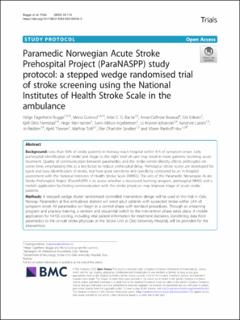Paramedic Norwegian Acute Stroke Prehospital Project (ParaNASPP) study protocol: a stepped wedge randomised trial of stroke screening using the National Institutes of Health Stroke Scale in the ambulance
Bugge, Helge Fagerheim; Guterud, Mona; Bache, Kristi Cecilie Grønvold; Braarud, Anne-Cathrine; Eriksen, Erik; Fremstad, Kjell Otto; Ihle-Hansen, Hege; Ingebretsen, Svein Håkon; Kramer-Johansen, Jo; Larsen, Karianne; Røislien, Jo; Thorsen, Kjetil; Toft, Mathias; Sandset, Else Charlotte; Hov, Maren Ranhoff
Peer reviewed, Journal article
Published version
Permanent lenke
https://hdl.handle.net/11250/3021778Utgivelsesdato
2022-02-04Metadata
Vis full innførselSamlinger
Sammendrag
Background: Less than 50% of stroke patients in Norway reach hospital within 4 h of symptom onset. Early prehospital identification of stroke and triage to the right level of care may result in more patients receiving acute treatment. Quality of communication between paramedics and the stroke centre directly affects prehospital on-scene time, emphasising this as a key factor to reduce prehospital delay. Prehospital stroke scales are developed for quick and easy identification of stroke, but have poor sensitivity and specificity compared to an in-hospital assessment with the National Institutes of Health Stroke Scale (NIHSS). The aim of the Paramedic Norwegian Acute Stroke Prehospital Project (ParaNASPP) is to assess whether a structured learning program, prehospital NIHSS and a mobile application facilitating communication with the stroke physician may improve triage of acute stroke patients.
Methods: A stepped wedge cluster randomised controlled intervention design will be used in this trial in Oslo, Norway. Paramedics at five ambulance stations will enrol adult patients with suspected stroke within 24 h of symptom onset. All paramedics will begin in a control phase with standard procedures. Through an e-learning program and practical training, a random and sequential switch to the intervention phase takes place. A mobile application for NIHSS scoring, including vital patient information for treatment decisions, transferring data from paramedics to the on-call stroke physician at the Stroke Unit at Oslo University Hospital, will be provided for the intervention. The primary outcome measure is positive predictive value (PPV) for prehospital identification of patients with acute stroke defined as the proportion of patients accepted for stroke evaluation and discharged with a final stroke diagnosis. One thousand three hundred patients provide a 50% surplus to the 808 patients needed for 80% power to detect a 10% increase in PPV.
Discussion: Structured and digital communication using a common scale like NIHSS may result in increased probability for better identification of stroke patients and less stroke mimics delivered to a stroke team for acute diagnostics and treatment in our population.
Utgiver
BMCSerie
Trials;23, Article number: 113 (2022)Tidsskrift
TrialsOpphavsrett
© The Author(s). 2022Beslektede innførsler
Viser innførsler beslektet ved tittel, forfatter og emneord.
-
Enjoyable company in sharing stroke experiences;- lifestyle groups after stroke
Lund, Anne; Melhus, Mali; Sveen, Unni (Journal article; Peer reviewed, 2017)BACKGROUND: Even people with mild to moderate stroke will experience changes in their abilities to perform everyday occupations. Group interventions may be appropriate in late-stage rehabilitation. The aim of this study ... -
A physical activity intervention to prevent cognitive decline after stroke – Secondary results from the LAST (Life After Stroke) study. An 18-month randomised controlled trial.
Ihle-Hansen, Hege; Langhammer, Birgitta; Lydersen, Stian; Gunnes, Mari; Indredavik, Bent; Askim, Torunn (Journal of Rehabilitation Medicine;Vol 51, Issue 9, Journal article; Peer reviewed, 2019-07-17)Objective: To examine the effects of individualized regular coaching and exercise on post-stroke cognitive and emotional function. Methods: The Life After STroke (LAST) study investigated the differences between intervention ... -
A long-term follow-up programme for maintenance of motor function after stroke: Protocol of the Life After STroke —The LAST study
Askim, Torunn; Langhammer, Birgitta; Ihle-Hansen, Hege; Magnussen, Jon; Engstad, Torgeir; Indredavik, Bent (Journal article; Peer reviewed, 2012-10-23)Background. There are no evidence-based strategies that have been shown to be superior in maintaining motor function for months to years after the stroke. The LAST study therefore intends to assess the effect of a long-term ...

